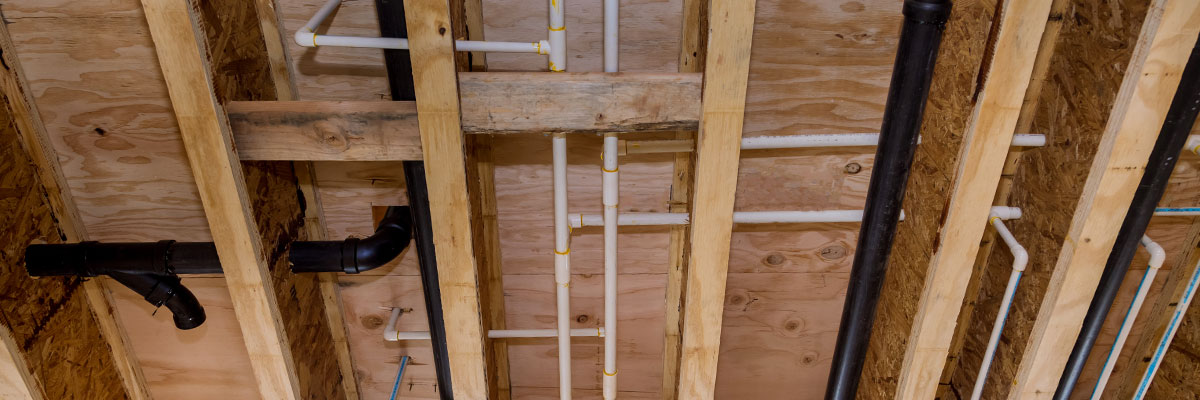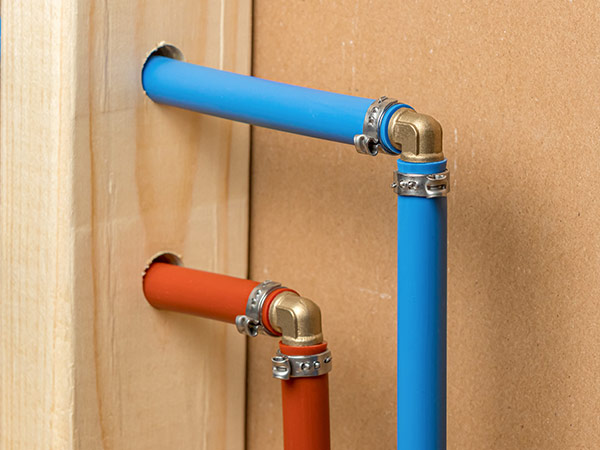

The Types of Plumbing Pipes in Your Home
The walls inside your home are filled with different types of plumbing pipes that work like veins to move drinking water and waste. Understanding the types of pipes you have will help make diagnosing any problems easier whether you are fixing them yourself or are describing them to a plumber. Our plumbing guide will help you understand the different pipes and how they work together.
How Your Home Plumbing System Works
Your home’s plumbing system has three major parts:
- Drains- Drain pipes are connected to your toilets, sinks, laundry, showers/tubs and carry waste to a municipal drain or septic tank. The municipal drains will take the waste to a dumping or recycling area, while a septic tank will leak the liquid waste out through a septic field. Solid waste will eventually need to be pumped from the septic tank. Drains have accessible cleanouts to give easy access if there is a blockage. These are typically located outside the home.
- Vents- As air and gravity pushes waste down the drain, negative air pressure is created. If not released, this could cause a major problem down the line. Vents at the top of your roof create a balance for the drain system and helps to keep sewer gas from coming up through your pipes.
- Potable Water- Potable water or “useable” water uses pressure to come into your home through water lines from your city utilities or a well. This water will flow through your water tank and a filtration system if you have one. You will have a water shutoff valve typically at each faucet or end-usage location, and one outside that shuts off the service to the entire house. If you are on city water, the city is responsible for maintenance and repairs if anything happens at the valve and the pipes leading to it. The homeowner is responsible for maintenance and repairs that happen on the pipes from the valve to the home.
Other Common Systems
- Rainwater Collection- Depending on how detailed your rainwater collection system is, it could be considered a part of your plumbing system. If you do not have a system, you might consider your options including gutters and rain barrels or an in-ground drain system.
- Gas- Believe it or not, if you have gas appliances they are considered a part of your plumbing system. Much like water valves, if you have gas the company is responsible for the meter and lines before it while you are responsible for where the gas flows into your home and anything after. If you smell gas in your home (like near your stove), turn off the gas and call a plumber.

6 Different Types of Plumbing Pipes and Their Uses

- Cast iron- These pipes are typically sewer waste lines and are mainly seen in older construction. If you’ve ever owned a cast iron pan, you know that they are susceptible to rust. This is the same with these types of pipes. While these pipes are strong and durable, they are also heavy to deal with and expensive.
- Copper- Used as potable water lines, copper is a common choice in many homes. While a more expensive option than plastic, they are durable and will not contaminate drinking water if you are concerned with plastic piping. They can corrode or thin and require a more extensive installation process as they will need to be soldered. They can be used above-ground and below.
- Supply lines- These flexible pipes are used to connect plumbing or fixtures to a main water line and are braided metal or plastic. These can be used in tight spaces and are easy to replace. However, they have a shorter lifespan than other materials.
- Galvanized steel- Found in older homes, these water supply lines are similar to cast iron in their likelihood of corrosion but come with a long lifespan. They are coated in zinc to help delay corrosion. Calcium buildup is also likely with galvanized steel. Installation and maintenance is a slow process.
- PEX- Made for indoor hot and cold water, cross-linked polyethylene is a popular option as it is great for complicated spaces. These flexible plastic pipes allow for easy installation and are a lower price point than other metal options. They are color-coded to help with easy identification as red lines are for hot water and blue lines are for cold. While exposure to UV and heat can cause damage, they are long-lasting if used correctly.
- PVC- When you think about plumbing pipes, PVC probably comes to mind first. Polyvinyl chloride pipes connect appliances to main water lines. If you look under your sink, you may find them. They are very durable and come in many different types depending on the application you need. CPVC is great for hot temperatures while DWV (drain waste vent) are wider to move waste. Another drain waste vent pipe is ABS (acrylonitrile butadiene styrene) and is great for a high-water temperature.
If you have a leak or a gushing break (yikes!), knowing which types of pipe(s) is the problem and what role it serves is the critical first step. If you’re ready to tackle some plumbing projects, stop by your local McCoy’s. We’re ready to serve you.
